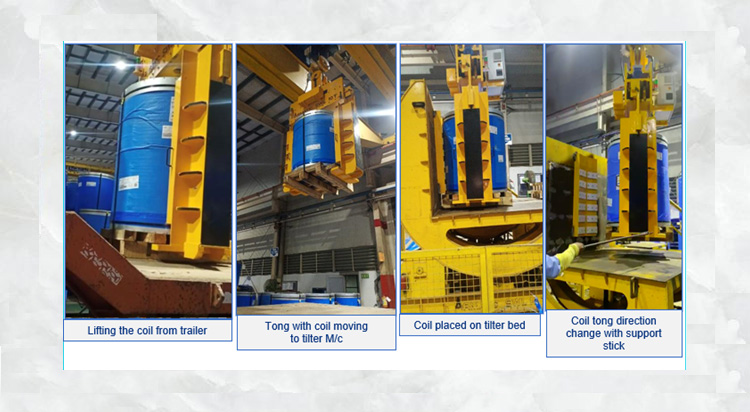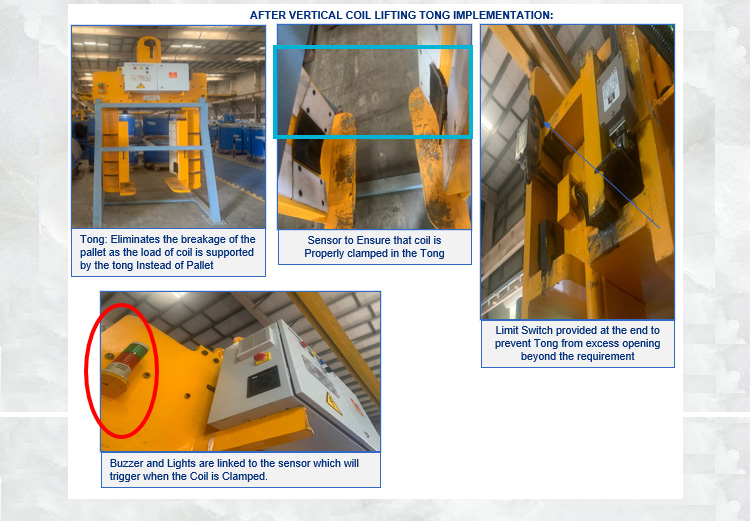Published on July 19, 2023
Construction Site Safety Initiative
Although the construction industry is one of India's largest employment sectors, it is also the second most hazardous, with an average of around 38 fatal accidents a day. According to a 2019 study by the Indian Institute of Technology (IIT) Delhi, falls, electrocutions and collapsing walls, and scaffolding at construction sites are the leading causes of work-related deaths in the construction industry. Another study published in 2016 by researchers at the National Institute of Technology Surat and IIT Delhi estimated that the construction industry accounts for around a quarter of all workplace accident fatalities in India.
Tata BlueScope Steel (TBSL) has been operating in the construction space for over a decade. The company has observed that no safety-related course or certification is provided by any institute specifically for the construction industry, which is more vulnerable to accidents at the site/work. The nature of the work being undertaken at construction sites is fraught with risks such as falling objects, falls from heights, electrocution, heavy material handling by cranes and the collapse of structures. The fallout of these types of accidents can be fatal. The site workers would consequently benefit from a personalised safety course covering these relevant topics.
TBSL initiated a discussion on this need with Construction Industry Development Council (CIDC), a government body constituted under Niti Aayog and dedicated to capacity building and skill upgradation of the building and construction industry. Through the deliberations, a 2-day training cum certification programme was designed, named ‘Kawach’. This programme included overall safety at construction sites, such as working at height, material handling and practical training on using PPE.
Through this course, workers would learn not only to work safely but also secure a certificate from industry recognised body that would be helpful for their future careers. The programme was launched at one of the construction sites of TBSL, and covered 120 contract workers in two batches.
TBSL is advocating for employing certified construction workers and is currently ensuring the same for all construction sites where it operates. Furthermore, the company is working on creating scustomised living spaces at construction sites to provide habitats to the workers. Many construction workers have poor employment conditions and protections, and their work is often a dangerous, ill-equipped site. A more extensive acceptance of such practices from the industry will go a long way in reducing construction site fatalities.
Fall protection mechanism at Coated Steel Plant, Jamshedpur
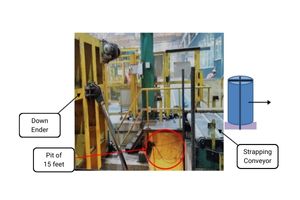 At TBSL, risk control projects are an integral component of the HSE strategy, which promotes team member engagement to increase the resilience of the HSE controls in their workplace.
At TBSL, risk control projects are an integral component of the HSE strategy, which promotes team member engagement to increase the resilience of the HSE controls in their workplace.
At the Jamshedpur midstream plant, a risk was identified in the Pack Line Down-ender unit (being used for coil turning). People carry out manual strapping activity near an open pit 15 feet deep. The area had highly unsafe conditions of falling hazards. Workers were at risk if they strapped the coil from the pit side due to the following reasons:
- Fall of a person from a Height of 15 feet (Severity-4)
- Crushing of person between down-ender and Roller Platform (Severity-4)
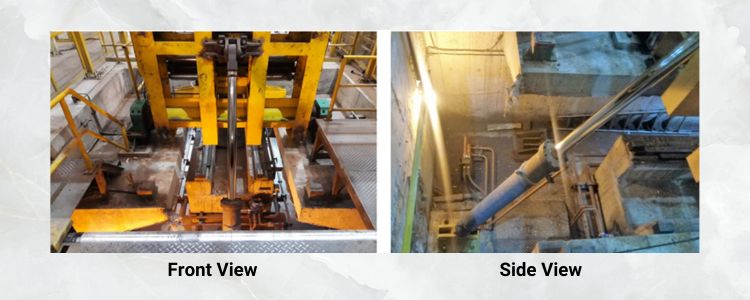
The solution for the same was guillotine barricading (fall protection) by applying Karakuri Kaizen - Wire rope and pulley-based mechanical solution methodology.
The barricading used eight in-house fabricated pulleys, a 6-mm diameter wire rope of length ?10 meters and an in-house fabricated barricade of 1900 mm X 1200 mm.
There were several challenges in doing this. There was only an 80 mm gap to accommodate the movement of a barricade. Deciding the length of wire rope for the same movement of the barricade was critical as the barricade was to be appropriatedown to avoid interference with the down-ender frame. Additionally, the path of the wire rope must not interfere with the movement of the down-ender etc.
The solution of moving the barricade with wire and pulley arrangement works simultaneously as the working of down ender frame. When it is in the position where the pit is open, barricading automatically comes up and goes down when the pit is closed hence providing no hindrance in normal working.

This way, the falling hazard associated with the manual strapping operation was eliminated through the innovative and in-house design of a moving barricades that operate with no extra energy consumption. Other benefits of this solution include less cost of installation or maintenance, simple design, no automation and sequencing required, etc.
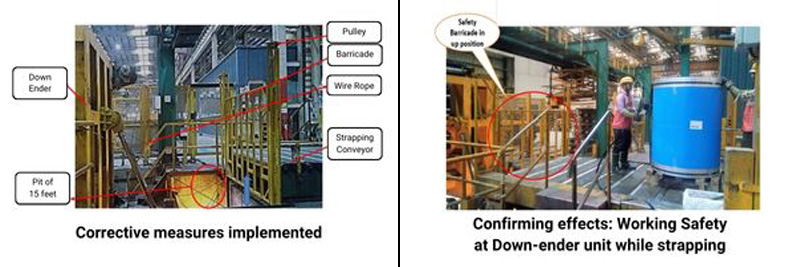
Elimination of Human-Machine Interface through Innovation
At the Jamshedpur plant of TBSL, Metal Coating Line (MCL) is meant to produce coated steel products while processing Cold Roll Full Hard (CRFH) steel coil through cleaning section, furnace and pot. The furnace temperature is up to 1300 deg C and is equipped with water-cooled and non-cooled hearth rolls for strip passage.
The entry seal roll is one of the water-cooled heart rolls situated outside of the furnace, which is at 45 deg C. Due to the temperature difference between the furnace (temp. 800 deg C) and the entry seal roll, moisture is deposited directly on the entry seal roll surface. Carbon particle deposition over time, in conjunction with the wet surface of the entry seal roll, is developed into a slurry that carries forward on the bottom surface of the running strip, causing uncoated defects leading to non-prime products.
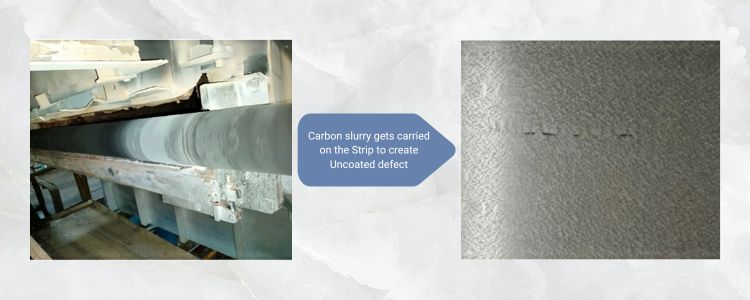
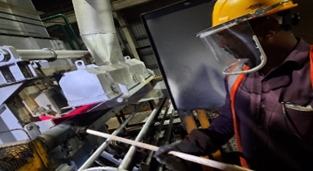 Periodic cleaning of the entry seal roll is required to prevent defects on the strip due to contamination on the roll. MCL must be stopped as the person goes inside, causing a direct interface between human and machine within the vicinity of the hot furnace roll. The operator used to go inside and clean the hot entry seal roll with the help of rod and cotton patches attached, which had a high potential risk of burn injury.
Periodic cleaning of the entry seal roll is required to prevent defects on the strip due to contamination on the roll. MCL must be stopped as the person goes inside, causing a direct interface between human and machine within the vicinity of the hot furnace roll. The operator used to go inside and clean the hot entry seal roll with the help of rod and cotton patches attached, which had a high potential risk of burn injury.
The team implemented a solution of attaching the cleaning rod to a movable shaft which was then moved by operator with the help of a rotating wheel. In this case, the operator would be cleaning from outside the machine, thus eliminating any contact and reducing the risk of injury.
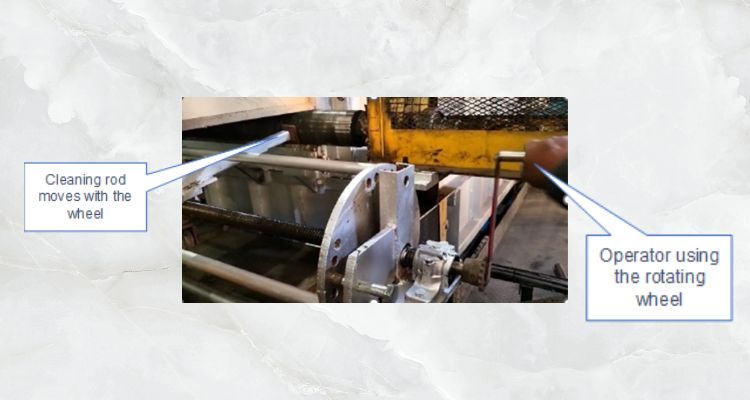
Several benefits were srealised after implementing this solution:
- Safety: Man-Machine interface is eliminated from the process
- Productivity: The process of cleaning the furnace entry seal is streamlined
- Quality: Periodical removal of carbon deposition from roll
- Cost: Line stoppage reduced to zero
Smart Controls for reducing ergonomic risk
TBSL downstream plants carry out the operation of roll-forming coated steel coils to create various profile sheets that are used for roofing or wall cladding.
At TBSL’s downstream facility at Bhiwadi (Rajasthan, India), the team located an issue while reviewing HIRA at Trimdek® Machine Operations. It was noted that there was a potential risk of injury for ergonomic reasons. Working in awkward postures or being in the same posture for long periods were the leading causes.
The production on the Trimdek® machine is 30-50 MT per sheet, and five people are required to handle sheets to operate.? The weight of each sheet is approx. 20-30 kg.?
The team carried out Root Cause Identification as below:
- What? Physical effort
- When? While operating on the Trimdek machine
- Why? The process required manual handling of sheets
- Why? The existing design of the machine didn’t support automation in sheet handling
Through internal brainstorming, the team improved the process by provisioning auto stacker and pusher. It was ensured that the operation of the machine was safe and there was minimum Human-Machine interface.
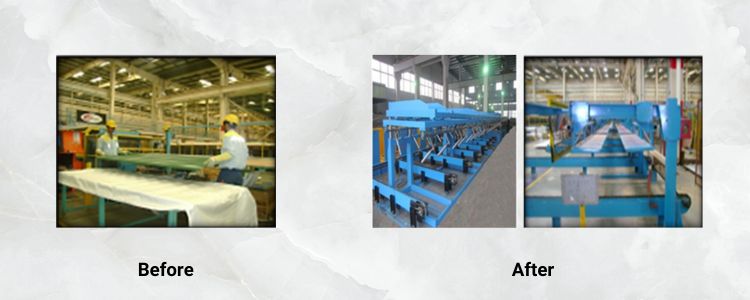
The process modification led to not only enhanced safety and betterment of ergonomic conditions, but also efficiency as the workforce required to conduct the activity reduced from five to three. This also led to significant cost savings for the production.
Implementation of coil handling controls
TBSL downstream plants carry out the operation of roll-forming coated steel coils to create various profile sheets that are used for roofing or wall cladding.
The team had noticed a rise in incidents while handling Bore Verticals coils with chains/slings.
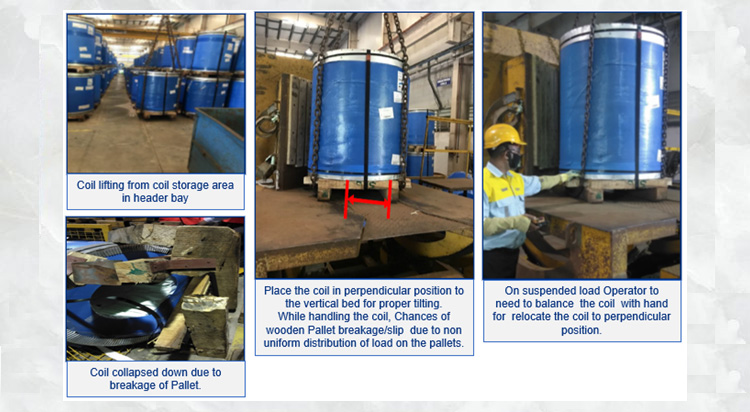
As per the scheduling of Trimdek® operation, the coil is to be taken from the vertical coil storage area by EOT crane with the help of chain sling to coil tilt area for tilting operation by an associate. The coil tilter is installed in Header Bay, a nearby vertical (one above one) coil storage area. The vertical coil handling continues by chain sling for unloading from the trailer and is then shifted to the tilter bed. Currently, the coils are handled with the help of chains. The likelihood rating of accidents is high.
To reduce the risk, the team implemented a coil lifting tong. The implementation has resulted in the elimination of the Human-Machine interface. The explicit design and mechanised operations mitigate coil fall risk. Trigger alarm of buzzer and lights are linked to the sensor, which trigger when the coil is clamped, resulting in a further reduction of risk.
